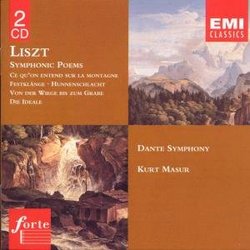| All Artists: Franz Liszt, Kurt Masur, Leipzig Gewandhaus Orchestra, Matthias Eisenberg Title: Liszt: Symphonic Poems Members Wishing: 0 Total Copies: 0 Label: Angel Records Release Date: 9/10/1996 Genre: Classical Styles: Forms & Genres, Theatrical, Incidental & Program Music, Symphonies Number of Discs: 2 SwapaCD Credits: 2 UPC: 724356859821 |
Search - Franz Liszt, Kurt Masur, Leipzig Gewandhaus Orchestra :: Liszt: Symphonic Poems
 | Franz Liszt, Kurt Masur, Leipzig Gewandhaus Orchestra Liszt: Symphonic Poems Genre: Classical
|
Larger Image |
CD DetailsSimilar CDs |
CD ReviewsEXCELLENT - the best Dante-recording ever!!! Gergely Kiss | Hungary | 12/23/2002 (5 out of 5 stars) "The Dante-symphony is one of Liszt's two symphonies: it shows the most striking examples of Liszt's use of the orchestra. The Inferno movement brings us into the dark depth of suffering with chromatic and whole-tone sequences. Liszt writes very important lines for - in the mid-19th-century usually non-favoured -instruments like bass-clarinet, double-bass, harp, tam-tam, low-brass - and Kust Masur understands the significance of this. The interpretation of the whole movement is simply perfect! Liszt once said that the main theme shortly after the beginning should sound like mocking devils - and it does indeed! The Purgatorio is pictured equally wonderfully - the Gewandhaus Orchester is playing with extreme beauty: there is no other recording where the string accompaniment would sound as otherworldly as on this disc. The final Magnificat with the women's choir takes us to the gates of heaven: we can hear the angels singing. The work fades away with delicate, pianissimo woodwind chords.The "What One Can Hear on the Mountain", the first piece on disc1 was the first symphonic poem in music history - inventive and revolutionary. Although it is the longest of all the Liszt-symphonic poems Masur manages to avoid being halting. The same is true in connection with Die Idealen: most of the conductors fail to bring out all of the beauties of this great work, but Masur and the Gewandhaus succeeds again.
Festklange is as its title tell us a musical fiesta - in a very elegant manner. It was written in the happy days when Liszt still thought that he will be able to marry the Polish Princess Sayn-Wittgenstein... The "Battle of the Huns" is an interesting piece: in my opinion the first 6 minutes includes the most exciting battle-scene ever been written for orchestra. When the battle is over the music reaches a climax with organ and fortissimo tutti - the only weak point of the composition for me... the rest of the music is great again to the end. From the Cradle to the Grave - the last symphonic poem from Liszt. He composed it nearly 30 years after the previous one. It does show huge differences from the previously mentioned works. It is extremely modern - especially compared to the works of Brahms, Tchaikovsky, Elgar dating from the end of the 19th century. But it also sounds much more 20th-century than either Wagner or Franck. The Cradle movement is written delicately for five violins, flute and harp - i can not describe it, You have to hear it... The Life-movement starts of with a strikingly modern motif: very percussive and violent with its tritone, but soon it gets combined with a joyous second theme - leading to a crazy chaotic end linking the music to the Grave-movement, which doesn't introduce any new themes, it transforms the music from the previous two movements suggesting that the Grave is the Cradle of an other Life. The music fades away with a simple, pianissimo, truly beautiful cello line.All together: GREAT MUSIC AND GREAT INTERPRETATION." |

 Track Listings (6) - Disc #1
Track Listings (6) - Disc #1